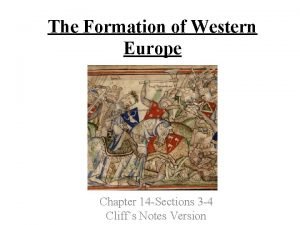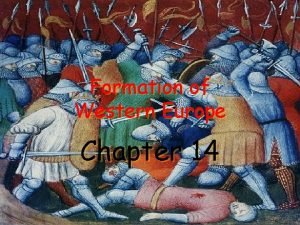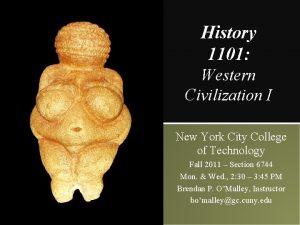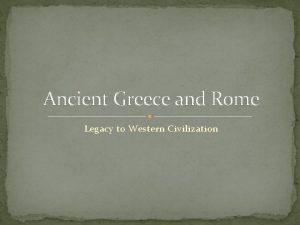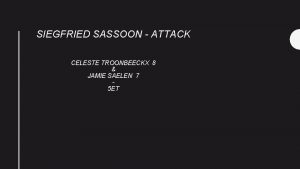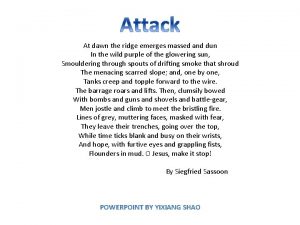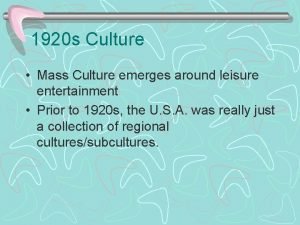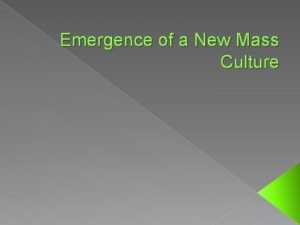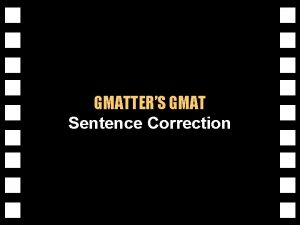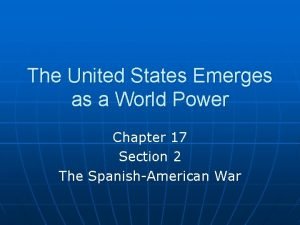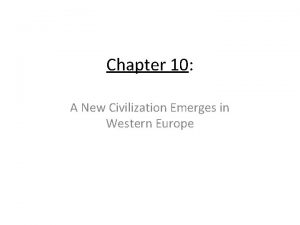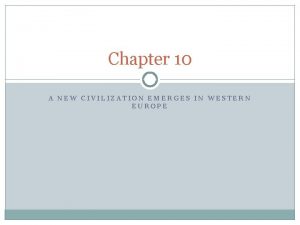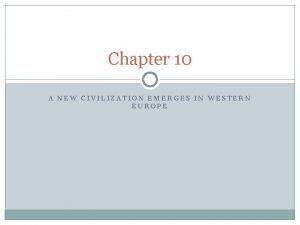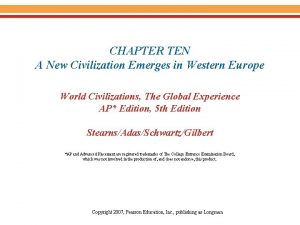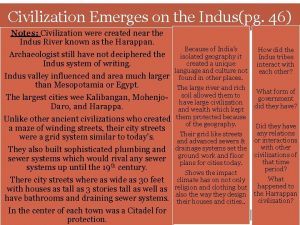A New Civilization Emerges in Western Europe Chapter










- Slides: 10

A New Civilization Emerges in Western Europe Chapter 10 | APCIV

“Their bodies are large, their manners harsh, their understanding dull and their tongues heavy. Those who are farthest to the north are the most subject to stupidity, grossness, and brutishness. ” HOW AND WHY SUCH CONTRASTING TRENDS? Western European history from the fall of Rome to the 15 th century CE is known as the Medieval Period (a formative period) They would be culturally and intellectually behind the rest of the civilized world, one Muslim visitor writing : Yet, Western Europe would produce brilliant minds: Thomas Aquinas This period lasts about 1000 years: the Early Middle Ages | the High Middle Ages | the Late Middle Ages The Early Middle Ages The High Middle Ages The Late Middle Ages

• 550 -900 CE: Western Europe faced a number of problems • • • Rome continued to serve as the center of the Roman Catholic Church • This institution would become the most powerful entity in the West Most W European kingdoms were weak and divided Islam occupied southern Italy and Spain • Though their intellectualism would assist W European development There were frequent movements (invasions) of peoples • The Vikings from the north, the Magyars from Asia, Muslims from the south Life was simple, brutish, and hard (intellectualism nearly vanished) • The Manorial System: Obligations and Allegiances • Manorialism as a system of economic and political relations between landlords and their peasant laborers (often times serfs) • Politically decentralized and local, economically subsistence farming • Development was slow: the moldboard plow c. 9 th century to better cut into northern European soil (Mediterranean plow was lighter) • Three-field systems emerged: farming 2/3 of your land letting 1/3 lay fallow • The Church’s spiritual and political power • The only surviving institution with political organization, clout, and wealth • It would mimic the organizational structure of the Roman Empire (bishops/diocese answered to Pope) • The spread of Christianity, in turn, spread the authority of Rome • Conversions of Pagan kings to Christianity earned the respect, prestige, and wealth of Rome • This connection and political respect drove Pagan kings to convert (Clovis of the Franks was first: 496 CE) Stages of Postclassical Development The Early Middle Ages The High Middle Ages The Late Middle Ages

• One dynasty of Franks (the Carolingians) grew powerful with their early authority (Clovis’ conversion and recognition) • Charles Martel’s victory over the Muslims at Tours 732 CE • Seen as a savior to the West from Islam • His successor would spread Carolingian power north and east • This large-scale unification and acceptance by Rome was seen as a return to stability • The Pope, eager for a protector (Byzantium was busy fighting its own wars) crowned Charlemagne “Roman Emperor” on Christmas Day, 800 CE • Charlemagne would renew some intellectual activity through Church education: the missi dominici as a form of bureaucracy • Upon his death, Charlemagne's empire would be divided into 3 regional kingdoms: these would form the basis of later kingdoms • This civilization lacked unity outside of Christianity • Various vernacular languages emerged and Latin was only spoken in the Church: Germanic languages mixed with Latin to form Romance • Competition to be “successor” to Rome grew • The eastern part of Charlemagne's divided empire (Germany/Italy) claimed leadership • The Pope, seeing a threat/protector, crowned Otto the Great “Holy Roman Emperor” in 962 CE The “Rebirth” of Rome The Early Middle Ages The High Middle Ages The Late Middle Ages

• Urban life began to grow as increased agriculture gave rise to local markets • Foreign goods would be brought by merchants from distant cities to buy/sell: population growth encouraged this • Durum wheat from North Africa (for making pasta) and alfalfa from Persia spread through markets, increasing productivity • Merchants became uniquely special mediums between this exchange in society • Cities grew (5% of W European population: 15% in Asia) • Few European cities reached 100, 000: Asia had 52 larger cities • Political life was tied to land: Kings and Vassals (manorial) • Real power v. Perceived power = centralization v. decentralization • England: established by William Duke of Normandy (Viking decent) • Handed out land to nobles: established a Norman (French) court ruling over Anglo-Saxon (Anglish) people • France: the Capetian Dynasty of rulers, centered around Paris, began to exert their influence on neighboring lords via war/marriage • Would become so powerful by 14 th century that the Church would fight it • Germany: Holy Roman Emperors would amass great power over flourishing German cities Expansion of Medieval Life The Early Middle Ages The High Middle Ages The Late Middle Ages

• Feudalism necessitated conflict between landed elite and their overlords • England, in 1215, would reach a revolutionary agreement • King John’s nobles would fight and beat him: forced him to sign the Magna Carta • Confirmed an agreement for the king to respect and work with nobles • This led to the creation of Parliament 1265: a body of nobles whom assisted in making decisions • This system developed elsewhere but on smaller scale than England: Germany, Scandinavia, and Spain all had versions (French Estates) • Still, the overall power of European monarchs was far inferior to Asia • Feudal rights dominated politics and led to wars: The Hundred Years War 1337 • Aggressive Western European (Christian) Expansionism • German warlords waged holy war in the Slavic East (remaining pagans) • Warlords in Spain waged holy war against Muslims (Reconquista) • Feudal warlords of Europe waged holy war against Islam (Crusades) • Initiated by Urban II as a result of Byzantine collapse at Manzikert 1071 • Failed due to feudal competition moving from Europe to Palestine (Christians v. Christians) • Further internal conflicts over spiritual authority • Pope Gregory VII (f. 1080) and the Investiture Controversy • Claimed only the Pope had the spiritual authority to invest power in bishops (loyal to Church) Conflict and Expansion The Early Middle Ages The High Middle Ages The Late Middle Ages

DAY 2 Chapter 10 | APCIV

“I • would not be theology an Christian was the assimilation of faith and reason Aristotle if this were to • Even under Charlemagne, Aristotle was viewed as a fascinating character, part me from Christ. ” focusing on his rationality • However, this interest would be overshadowed by an overwhelming stressing on absolute submission to God’s word • Reason was seen as a means of better understanding God’s perfection • Peter Abelard (12 th century) wrote about contradictions in Church doctrine but stopped short of conviction, thus taking an impish stance on skepticism • Bernard of Clairvaux challenged Abelard stating that reason was dangerous to faith and God’s truth must be based on faith alone • Both Christianity and Islam would rely on “revealed faith” through Bible/Qur’an • By the 12 th century, W Europe was seeking Greek/Hellenistic documents that had been copied by Byzantium and Islam for centuries • Thomas Aquinas (13 th century) would make large moves in reason, but limited all of this to “faith comes first”: this notion became scholasticism • Popular expression of belief saw shifts to the veneration of Mary (more merciful than God) • Popular expression also expanded, sometimes unaware of its social/religious contradictions • The Epic of Raoul de Cambrai’s justification of murdering nuns as holy Western Culture in the Postclassical Era The Early Middle Ages The High Middle Ages The Late Middle Ages

“When Adam delved • Gothic architecture moved from Romanesque to more epic portrayals of and Eve span, Who was then a. Christianity gentleman? ”(assistance of Muslim design) • Expensive, time-consuming projects that expressed devout religious devotion • While most literature was written in Latin, new written expressions emerged in vernacular languages (French, German, and English) • These writings would be secular, and insight to average life: sometimes poked fun at the Church: Canterbury Tales • Courtly literature gave rise to an idealistic notion of chivalry, and tales of knights were sung by troubadours • Increasing access to literature gave rise to popular dissent of rich/poor • Growth of trade and banking • Regions like northern Italy, the Low Countries, and southern Germany saw the rise of capitalistic economies: banking and money • This money would fund businesses, ships, and trade (guilds grew to increase quality) • Commerce drove leagues of merchants (Hanseatic League) to expand trade • Merchants grew more powerful in the West bc of relatively weak states • By the Late Middle Ages (14 th C), society and economy in WE grew contradictory • Slow, socially stable life of agriculture contrasted fast, wealthy economic elite in cities The High Middle Ages The Early Middle Ages The High Middle Ages The Late Middle Ages

• Women were still limited (not as thoroughly as had developed in the Islamic world) • Their treatment contradicted early Christian acceptance of women, as their role became increasingly submissive and contained • In contrast to Islam, however, women did not have property rights in Christian Europe, and male-dominated enterprises would limit women • Kings began to seek easier methods of power • Personal mercenary armies became popular (and more loyal) • Military technology eclipsed the realm of the knight • The Hundred Years’ War: Crecy 1346, Poitiers 1356, and Agincourt 1415 • Kings became frustrated with the Roman Catholic Church’s dominance • Disputes over how to rule their own country (Common Law: Thomas Beckett) • Popes and anti-Popes would form, spending exorbitant amounts of money on questionable causes • Increase of trade (coupled with unsanitary lifestyles) led to the spread of disease • The Black Death would arrive via the Silk Road and devastate Europe 2/3 • Expanded contacts with neighboring regions gave rise to needed imitation • Byzantine/Arab influence penetrated the educated elite • This feudal period can resemble Africa/Japan, but a unique expansionist zeal defined WE Leaving the Middle Ages The Early Middle Ages The High Middle Ages The Late Middle Ages
 Chapter 14 the formation of western europe
Chapter 14 the formation of western europe Chapter 14 the formation of western europe
Chapter 14 the formation of western europe Roman contributions to western civilization
Roman contributions to western civilization Western civilization
Western civilization Rome and the roots of western civilization
Rome and the roots of western civilization At dawn the ridge emerges massed and dun
At dawn the ridge emerges massed and dun At dawn the ridge emerges massed and dun
At dawn the ridge emerges massed and dun Modern mass culture emerges leisure
Modern mass culture emerges leisure Modern mass culture emerges leisure
Modern mass culture emerges leisure Gmatter
Gmatter The united states emerges as a world power
The united states emerges as a world power
